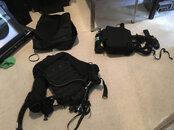telemonster
Contributor
The tactical BCD thingy, Front. CCR clips onto the 4 clips, top two are slightly larger than bottom two. Bottom seem to be 40mm ITW Nexus, Top might be 45mm

Included carrying case. Has a padded panel as well. Silver things are the fill adapters I had to source from the UK.

Tactical BCD back, with tiny cylinder for BCD inflation (no burst disc)

O2 cylinder with the funky valve that I need rebuild kit for. Has SPG, manual injection button and bib for connection to bag

Unit with the cloth outer bag open exposing the loop. Nice mouthpeice, has gag strap. No flood protection.

View of the soft bag that goes over the unit. The waist belt was home made and included by prior owner, but the top one was not. It also had two smaller clips added at the top of the unit, possibly for the escape from Dubai

Another view of the kit

I didn't full assemble it but there is how the O2 cylinder usually sits.

Included carrying case. Has a padded panel as well. Silver things are the fill adapters I had to source from the UK.
Tactical BCD back, with tiny cylinder for BCD inflation (no burst disc)
O2 cylinder with the funky valve that I need rebuild kit for. Has SPG, manual injection button and bib for connection to bag
Unit with the cloth outer bag open exposing the loop. Nice mouthpeice, has gag strap. No flood protection.
View of the soft bag that goes over the unit. The waist belt was home made and included by prior owner, but the top one was not. It also had two smaller clips added at the top of the unit, possibly for the escape from Dubai
Another view of the kit
I didn't full assemble it but there is how the O2 cylinder usually sits.




